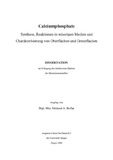Citation link:
https://nbn-resolving.org/urn:nbn:de:hbz:467-619Files in This Item:
| File | Description | Size | Format | |
|---|---|---|---|---|
| Dissertation_Michael_Alexander_Bufler.pdf | 13.32 MB | Adobe PDF |  View/Open |
| Dokument Type: | Doctoral Thesis | metadata.dc.title: | Calciumphosphate : Synthese, Reaktionen in wässrigen Medien und Charakterisierung von Oberflächen und Grenzflächen | Authors: | Bufler, Michael | Institute: | Fachbereich 8, Chemie - Biologie | Free keywords: | Biomaterialien, Phasenumwandlung, Grenzflächen, Bindemittel | Dewey Decimal Classification: | 540 Chemie | GHBS-Clases: | UOD UOK UPB UPK UUN |
Issue Date: | 2004 | Publish Date: | 2015 | Abstract: | Calciumphosphate besitzen chemisch, strukturell und funktional nahezu identische Eigenschaften mit Knochen und Zähnen. Biomaterialien auf Basis dieser Verbindungen sind daher wichtige Komponenten für die Defektheilung in der mineralisierten Hartsubstanz des Menschen. Die Entwicklung von anwendungsorientierten und optimierten implantierbaren Biomaterialien (z.B. Bindemittel, Keramiken und Komposite) im System CaO-P2O5-H2O ist von herausragender Bedeutung. Detaillierte Kenntnisse über die ablaufenden chemischen Prozesse innerhalb der beteiligten komplexen Systeme können in erheblichem Maße zum Verständnis von Biomineralisationsvorgängen beitragen. Mechanismen auf Grund der Reaktion von Calciumphosphaten mit wässrigen Lösungen, insbesondere an Oberflächen und Grenzflächen, sowie die dabei entstehenden Produkte sind jedoch bisher weitgehend unbekannt. Die Erforschung dieser Prozesse und ihrer Auswirkungen auf die Materialien besitzt daher große Bedeutung. Die vorliegende Arbeit umfasst bezüglich dieser Problematik drei Hauptaspekte. Erstens das Verständnis struktureller Gemeinsamkeiten zwischen den Calciumphosphaten, insbesondere hinsichtlich Hydroxylapatit. Zweitens die phasenreine Synthese der relevanten Calciumphosphate. Drittens und dies ist das primäre Ziel dieser Arbeit, die Aufklärung und Charakterisierung der Materialoberflächen und Grenzflächen in Folge der Reaktion mit wässrigen Lösungen. In diesem Kontext wurden darüber hinaus anwendungsbezogen die Verbundeigenschaften zwischen einem Calciumphosphat Bindemittel und dem anorganischen Anteil des Knochens analysiert. Die vorliegende Arbeit beinhaltet die Analyse von Auswirkungen auf Grund von Lösungsvorgängen, Keimbildung, Kristallisation und Phasenumwandlung, sowie die Charakterisierung der Grenzflächen hinsichtlich der auftretenden Materialeigenschaften. Die Untersuchungen wurden insbesondere unter Verwendung von hochauflösenden mikro- und nanoskopischen Techniken (z.B. Rastersondenmikroskopie) und der Rietveld Methode durchgeführt. Die vorliegenden Ergebnisse besitzen Relevanz für die zielgerichtete Entwicklung von Calciumphosphat Biomaterialien und tragen außerdem zum Verständnis von Prozessen bei, die im biologischen System Einfluss auf die Biokompatibilität haben können. Calciumphosphate biomaterials are very important components repairing the mineralised tissue of humans. The chemical, structural, mechanical, and functional properties of these materials are very similar to teeth and bones. The development of application-oriented and optimized implantable biomaterials (e.g. cements, ceramics and composite materials) in the system CaO-P2O5-H2O is of great importance. A detailed knowledge of chemical processes in this complex system can help us to understand, to a considerable extent, very important aspects of biomineralization. For this reason the investigation of hydration mechanisms, chemical reactions especially on interfaces, and the products arising, which are not yet well understood, is of outstanding importance. This thesis covers three main aspects. First aspect is the understanding of structural relationships between calciumphosphates especially with respect to hydroxyapatite. Synthesis of the relevant phase-pure calciumphosphates is the second aspect. Third aspect is the investigation and characterization of calciumphosphate material surfaces, interfaces, and boundaries between calciumphosphate cements and denatured bone parts. This contains the observation of effects caused by solution, precipitation, crystallization, and transformation of phases and characterization of the interface regarding material properties as well. For these investigations especially high-resolution micro- and nanoscopic techniques (i.e. Scanning Probe Microscopy) and Rietveld analysis were performed. The results regarding this thesis can be useful to develop and optimize calciumphosphate biomaterials. In addition they can be helpful to understand processes which influence the biocompatibility in the physiological environment. |
URN: | urn:nbn:de:hbz:467-619 | URI: | https://dspace.ub.uni-siegen.de/handle/ubsi/61 | License: | https://dspace.ub.uni-siegen.de/static/license.txt |
| Appears in Collections: | Hochschulschriften |
This item is protected by original copyright |
Page view(s)
823
checked on Mar 11, 2025
Download(s)
211
checked on Mar 11, 2025
Google ScholarTM
Check
Items in DSpace are protected by copyright, with all rights reserved, unless otherwise indicated.

